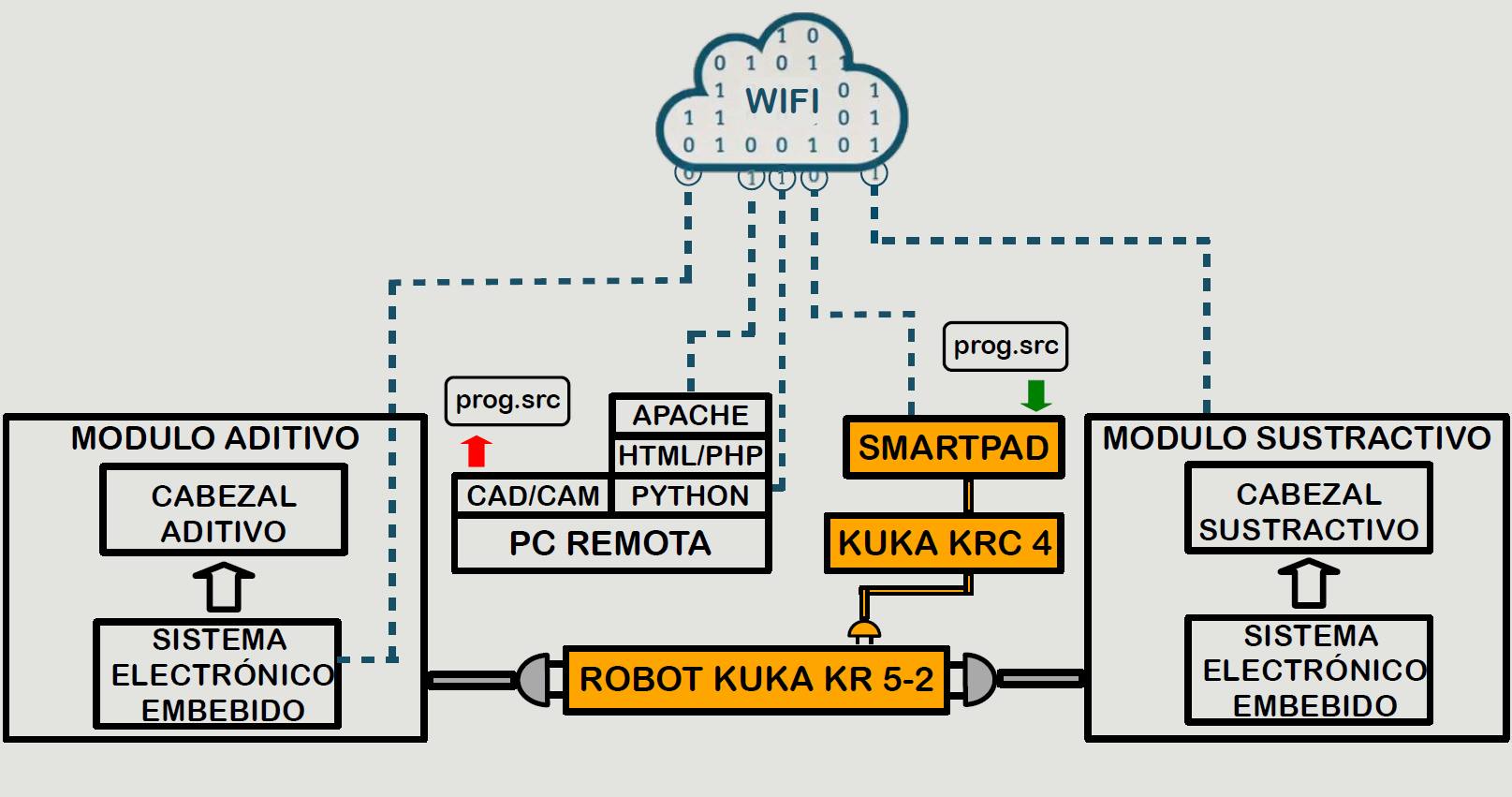Configurable hybrid integral manufacturing platform: subtractive-additive process with industrial robot arm, proof of concept results
Keywords:
Additive manufacturing, Subtractive manufacturing, Hybrid manufacturing, industrial robotic arm, Embedded electronic systems, Integral platformAbstract
In accordance with the new trends demanded by Industry 4.0, the idea of having manufacturing processes using industrial robotic arms with capabilities and functionalities to achieve reconfigurable and adaptable production, has become a novel research field. A new concept to have different manufacturing tools integrated and controlled by the same system arises, this new idea allows the implementation of integrated hybrid systems for manufacturing process purposes. In the last decade, the three-axis hybrid manufacturing has become a viable or promising option to cover these new needs, it shows the feasibility of achieving applications that combine additive and subtractive methods. However, it is still a challenge to implement this new concept with robotic arms aid manufacturing. This article presents an overview of developed systems using this hybrid integral approach up to now, which focuses on subtractive and additive manufacturing methods of 3D printing using robotic arms. The objective of this research, is to show the possibility of such approach to be develop as an integral manufacturing platform with an industrial robotic manipulator as the central element and a hardware-software sinergy concept, which allows the implementation of an integral hybrid manufacturing platform having different tools controlled by a unique system. The system allows to integrate others working production tools such a laser cutting device, just by way of attach the specific hardware and CAD/CAM design for the desired manufacture piece. Once the requirements and necessary components to develop the integral hybrid manufacturing platform have been established, a case of study for additive-subtractive manufacturing is presented. A proof-of-concept experiment is proposed and realized to demonstrate the manufacturing quality challenges that a system such as the one shown must face.
Downloads
References
W. Leontief, W. W. Leontief, F. Duchin, et al., The future impact of automation on workers. New York: Oxford University Press, 1986
M. Peña-Cabrera, V. Lomas, and G. Lefranc, “Fourth industrial revo-lution and its impact on society,” in 2019 IEEE CHILEAN Conference on Electrical, Electronics Engineering, Information and Communication Technologies (CHILECON), pp. 1–6, IEEE, 2019.
S. Keating and N. Oxman, “Compound fabrication: A multi-functional robotic platform for digital design and fabrication,” Robotics and Computer-Integrated Manufacturing, vol. 29, no. 6, pp. 439–448, 2013.
J. A. Saucedo-Martínez, M. Pérez-Lara, J. A. Marmolejo-Saucedo, T. E. Salais-Fierro, and P. Vasant, “Industry 4.0 framework for management and operations: a review,” Journal of ambient intelligence and humanized computing, vol. 9, pp. 789–801, 2018.
M. Bortolini, E. Ferrari, M. Gamberi, F. Pilati, and M. Faccio, “Assembly system design in the industry 4.0 era: a general framework,” IFAC- PapersOnLine, vol. 50, no. 1, pp. 5700–5705, 2017.
E. Uhlmann, S. Reinkober, and T. Hollerbach, “Energy efficient usage of industrial robots for machining processes,” Procedia CIRP, vol. 48, pp. 206–211, 2016.
R. Pérez, S. C. Gutiérrez, and R. Zotovic, “A study on robot arm machining: Advance and future challenges.,” Annals of DAAAM & Proceedings, vol. 29, 2018.
F. Rennung, C. T. Luminosu, and A. Draghici, “Service provision in the framework of industry 4.0,” Procedia-Social and Behavioral Sciences, vol. 221, pp. 372–377, 2016.
O. Rösch and M. Zäh, “Steigerung der arbeitsgenauigkeit von fräsrobotern-höhere genauigkeit durch steuerungstechnische kompensation der roboter-abdrängung (english: Increasing operational accuracy of milling robots),” wt Werkstattstechnik online, vol. 103, no. 9, pp. 686–692, 2013
M. A. Moktadir, S. M. Ali, S. Kusi-Sarpong, and M. A. A. Shaikh, “Assessing challenges for implementing industry 4.0: Implications for process safety and environmental protection,” Process safety and envi-ronmental protection, vol. 117, pp. 730–741, 2018.
E. Barnett and C. Gosselin, “Large-scale 3d printing with a cable-suspended robot,” Additive Manufacturing, vol. 7, pp. 27–44, 2015.
I. Bin Ishak, J. Fisher, and P. Larochelle, “Robot arm platform for additive manufacturing using multi-plane toolpaths,” in International Design Engineering Technical Conferences and Computers and Information in Engineering Conference, vol. 50152, p. V05AT07A063, American Society of Mechanical Engineers, 2016.
F. Wulle, D. Coupek, F. Schäffner, A. Verl, F. Oberhofer, and T. Maier, “Workpiece and machine design in additive manufacturing for multi-axis fused deposition modeling,” Procedia Cirp, vol. 60, pp. 229–234, 2017.
M. Vaezi, S. Chianrabutra, B. Mellor, and S. Yang, “Multiple material additive manufacturing–part 1: a review: this review paper covers a decade of research on multiple material additive manufacturing technologies which can produce complex geometry parts with different materials,” Virtual and Physical Prototyping, vol. 8, no. 1, pp. 19–50, 2013.
L. D. Evjemo, S. Moe, J. T. Gravdahl, O. Roulet-Dubonnet, L. T. Gellein, V. Br, et al., “Additive manufacturing by robot manipulator: An overview of the state-of-the-art and proof-of-concept results,” in 2017 22nd IEEE International Conference on Emerging Technologies and Factory Automation (ETFA), pp. 1–8, IEEE, 2017
P. Urhal, A. Weightman, C. Diver, and P. Bartolo, “Robot assisted additive manufacturing: A review,” Robotics and Computer-Integrated Manufacturing, vol. 59, pp. 335–345, 2019.
L. Li, A. Haghighi, and Y. Yang, “A novel 6-axis hybrid additive-subtractive manufacturing process: Design and case studies,” Journal of Manufacturing Processes, vol. 33, pp. 150–160, 2018.


